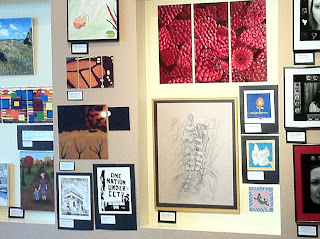Yesterday, the latest issue of Prep Talk and the 2012 Commencement Supplement appeared in my mailbox. Oh, the class of 2012 - they gave their smiles, performances and insights generously. Eli Weinstein (2012) penned the following eloquent and relevant piece for the blog. Thank you, Eli.
June, 2012.
There’s definitely a difference between libraries that are really, really big and libraries that are small. If you’re a librarian in a really big library (or a really big bookstore), you just buy every book you see and let your collection grow. And your job mainly comes down to organization: keeping track of where all the books are, making sure they’re in good shape, knowing your Dewey Decimal System really well, etc. But librarians who run small libraries have an extra problem. They have to make decisions: of all the books in the world, which ones do they order? Which ones do they display?
If you think about it, this is actually a very sophisticated challenge. A librarian rarely knows in advance exactly what each book they buy will be used for. Instead, they have to decide what could be useful – what’s interesting, what’s thought provoking, what’s engaging. A good librarian at a small library is like an expert wine taster, or a skilled museum curator. They have to have taste. And they have to have taste not simply in books or in writing, but in information.
If you think this is trivial, let me assure you – it’s not. There are a lot of second rate libraries and bookstores out there. You walk into them and you find yourself getting bored far too easily, you start browsing more quickly, taking books out and then immediately putting them back. I’ve spent far more quality time in Prep library aisles than in aisles ten times as long in other libraries, and it’s not simply that each of the books individually is unusually interesting – it’s that the collection fosters connections. It lets you see, physically, relevant information across disciplines. It’s a truly interdisciplinary location.
There’s one really big trap, though, that libraries and bookstores often fall into. It has to do with book displays. The standard book display is all devoted to new books, to recent arrivals, to the latest releases. It’s devoted to staying on top of the trends, like a Twitter newsfeed. In contrast, the truly great book displays, like ours at Prep, provide a mix of old and new. The reason this is so profound is that it creates connections. It shows continuity in intellectual history, it shows where the new books come from, and then suggests to you – you the thinker, you the actor in the modern world – where things might be going.
Pasadena’s Vroman’s Bookstore has stayed in business for 118 years, and the reason is not simply because it’s got a great atmosphere, or a café, or stationary. Remember, Border’s had all those things but went bankrupt. It’s that it knows how to pick books. It doesn’t just auto-order from the major publishers; instead, it finds things that are interesting, and puts Herodotus next to Jared Diamond, or the Human Rights Watch Annual Report next to a business best-seller. It lets its staff review and suggest books, and ends up with a supremely engaging collection, not unlike Prep’s own.
But why is all of this so important? Aren’t libraries and bookstores becoming anachronistic? Won’t the inevitable march of information technology push them to the side?
Frankly, it might happen. Libraries, sadly, might become out of date. But librarians, I think never will. In fact, they will become more and more important, precisely because of their talents as information connoisseurs. In the modern age’s blizzard of information, we need people to act as guides, to help sort the relevant from the inane, the interesting from the boring, the profound from the shallow. And good librarians have that skill in spades.
One thing to keep in mind though is that librarians are far more sophisticated thinkers than the news aggregation sites the modern web is filled with. The critical difference is that librarians think with more dimensionality. A site like the Huffington Post is driven by headlines: it has short articles and they’re all dealing with the present. Librarians, by contrast, have to think with enormous depth. The stock of their trade is not flat articles, a few pages long at most, but rather books: deep, three dimensional objects, which provide a range of information not only among them but within them. Furthermore, librarians, unlike news sites, must be aware not only of the present but of the past, and even of the future. They have to think infinitely harder. They are literary geniuses to the Huffington Post’s trashy paperback writers.
So, as you face the complex and dizzying future, keep in mind that you are not without help. Find yourself some good libraries, some good bookstores, some good librarians; they’ll lead you through the storm. And best of all, you ca
n start with Prep’s very own – they just so happen to be the best in the business.
-Eli Weinstein, Class of 2012



































